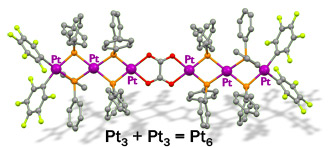|
The di- and trinuclear derivatives [(RF)2Pt(μ-PPh2)2Pt(CH3CN)2], 1, [(RF)2Pt(μ-PPh2)2Pt(μ-PPh2)2Pt(CH3CN)2], 2, (RF = C6F5) behave as synthons of di- and trinuclear fragments. Addition of azide and oxalate ions to 1 and 2, even in an excess, provides a way to isolate the tetranuclear and hexanuclear platinum complexes [NBu4]2[{(RF)2Pt{(μ-PPh2)2Pt}n(μ-1,1-N3)}2] (n = 1, 3; 2, 5), [NBu4]2[{(RF)2Pt(μ-PPh2)2Pt}2(μ-C2O4-σ2O,O′: σ2O″,O)}], 4, and [NBu4]2[{(RF)2Pt(μ-PPh2)2Pt(μ-PPh2)2Pt}2(μ-C2O4-σ2O,O′: σ2O″,O)}], 6. The structures of 3–6, determined by single crystal X-ray diffraction, show a linear arrangement of the platinum centres maintained through “Pt(μ-PPh2)2Pt” and “Pt(μ-1,1-N3)2Pt” or “Pt(μ-C2O4-σ2O,O′:σ2O″,O)Pt” bridging fragments. Finally, addition of KCN to 2 affords the trinuclear [NBu4]2[(RF)2Pt(μ-PPh2)2Pt(μ-PPh2)2Pt(CN)2], 7, in which two cyanido groups are bonded to the platinum centre in a terminal way.
|

